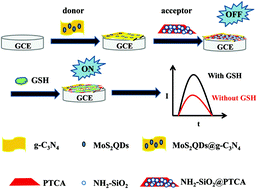A novel electrochemiluminescence sensor based on resonance energy transfer from MoS2QDs@g-C3N4 to NH2-SiO2@PTCA for glutathione assay†
Abstract
In this work, a solid-state electrochemiluminescence (ECL) sensor based on resonance energy transfer (RET) was proposed using MoS2QDs@g-C3N4 as a donor and NH2-SiO2@PTCA as an acceptor. Herein, MoS2QDs could significantly facilitate the stability and efficiency of the ECL of g-C3N4. PTCA provided a large platform to anchor NH2-SiO2 nanoparticles. The prepared MoS2QDs@g-C3N4 exhibited good spectral overlap with the UV–vis absorption spectrum of NH2-SiO2@PTCA. Based on this, we designed an “off–on” ECL sensing strategy for sensitive and selective detection of glutathione (GSH). Under the best conditions, the linear range of the sensor for GSH detection was from 0.001 to 100 μM with a detection limit of 0.63 nM (S/N = 3). More importantly, GSH in commercial samples can be detected using the proposed sensor, which indicated its superior detection capabilities and potential application value in commercial medicines.

- This article is part of the themed collection: Analyst Recent HOT articles


 Please wait while we load your content...
Please wait while we load your content...